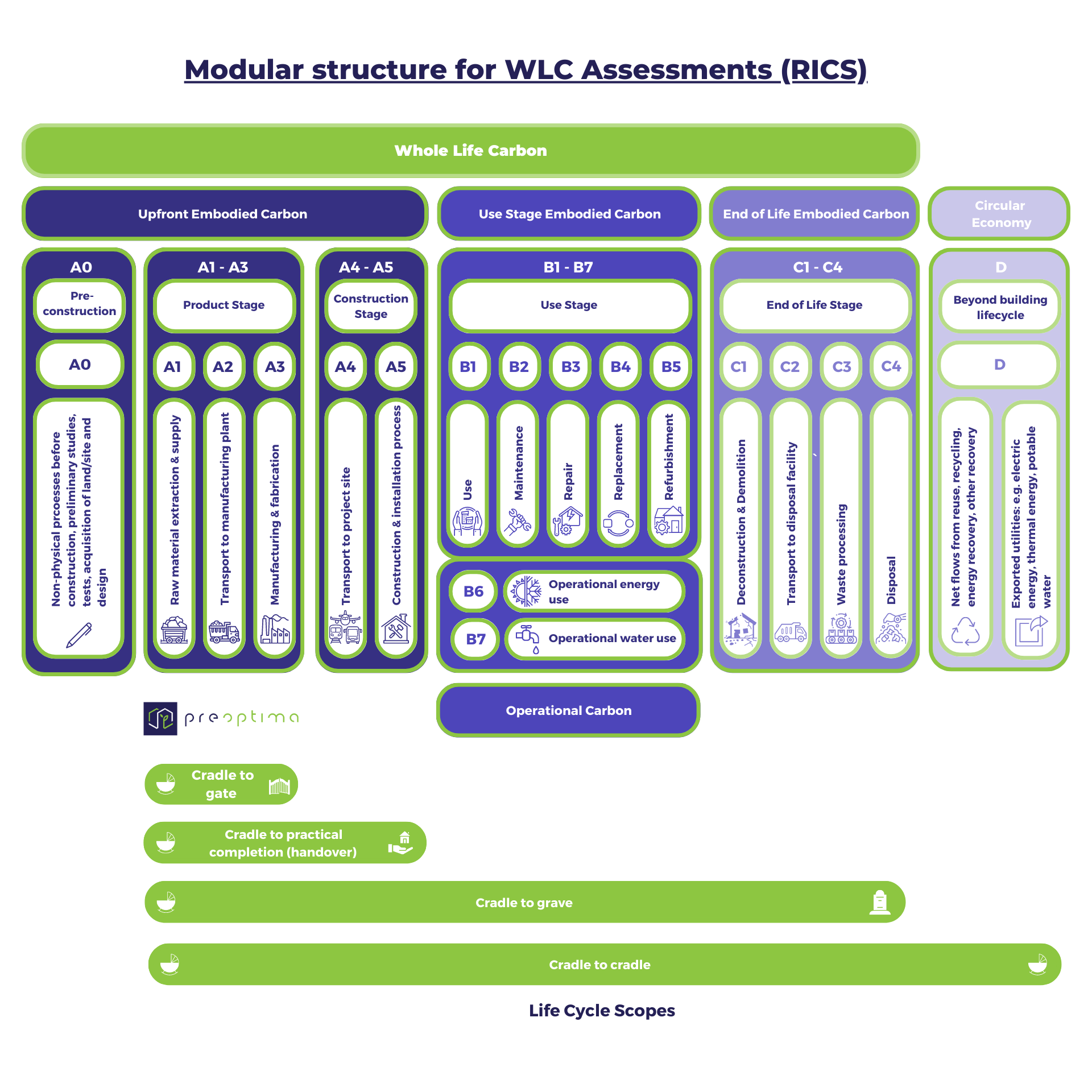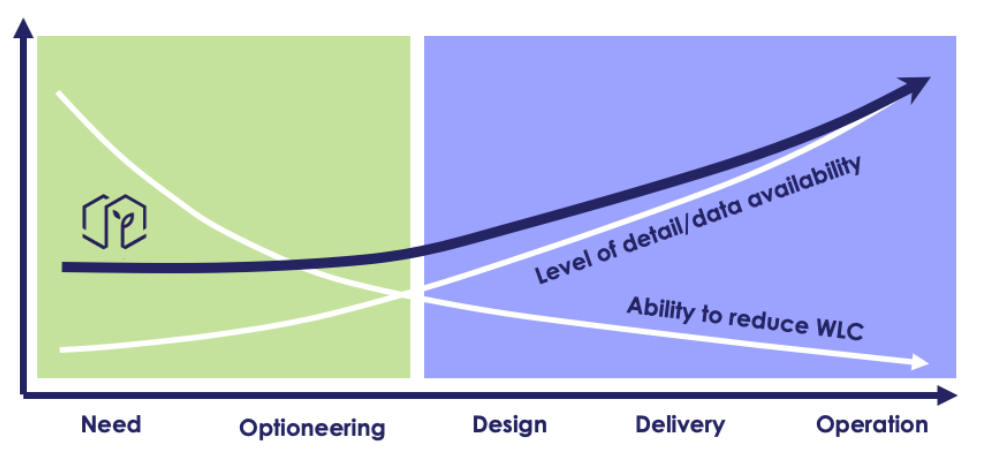RICS Whole Life Carbon Assessment 2nd Edition
Read Time 6 mins | Written by: Alex Bantock
The RICS Whole Life Carbon Assessment Standard 2nd Edition provides a comprehensive, globally applicable methodology for measuring and mitigating carbon impacts throughout the built environment lifecycle, promoting a unified approach towards carbon management and aligning the AEC sector with international sustainability pledges.
The Royal Institution of Chartered Surveyors (RICS) has once again asserted its commitment to combating climate change with the launch of its 2nd Edition of the Whole Life Carbon Assessment (WLCA) for the Built Environment Standard.
With growing concerns about climate change being met with noncommittal and undulating government action, the call to arms for professionals within the Architecture, Engineering, and Construction (AEC) sector is unequivocal – to adopt a unified, reliable methodology in measuring and mitigating carbon emissions throughout the lifecycle of built assets. The RICS WLCA 2nd Edition emerges as a linchpin in this mission, providing a robust, globally applicable methodology for carbon assessment and aligning the AEC sector with international emissions reduction pledges, such as the Paris Agreement.
Why the RICS Standard is Pivotal
Central to the RICS Standards framework is the overarching aim to operate in the public interest, nurturing the technical and ethical competence of the global chartered surveying profession. This ethos transcends into the WLCA, which is anchored on providing a consistent, data-driven, and comprehensive methodology for assessing carbon impacts throughout the built environment lifecycle. The standard is instrumental in galvanizing a unified approach towards carbon measurement and management, thereby aligning the industry with global sustainability commitments and RICS regulation.
Changes from the 1st to the 2nd Edition
The 2nd Edition of the RICS Professional Statement is a testament to the evolution of carbon assessment methodologies, building on the foundational principles of its predecessor while embracing a more holistic, global perspective. Unlike the 1st Edition, which was primarily tailored for the UK's built environment, the 2nd Edition extends its applicability globally, covering all built assets and infrastructure projects throughout their building life. This edition has also enriched the understanding of carbon costs and benefits associated with design choices in construction and infrastructure projects, making it a more comprehensive tool for carbon assessment and management.
RICS Whole Life Carbon Measurement
Whole Life Carbon (WLC) encapsulates the carbon impacts across three distinct realms: 'operational carbon', 'embodied carbon', and 'user carbon', with built environment carbon impacts mostly attributable to either operational or embodied carbon emissions. Operational carbon refers to the emissions from daily use of a building, like using energy and water. Embodied carbon includes the emissions from making and installing the materials a building uses, plus those from maintenance and eventual removal and disposal. User carbon relates to emissions from people using the building, beyond its operation, like commuting to a building or cars using a road.
The 2nd Edition delineates a structured approach for assessing these dimensions, breaking down the asset lifecycle into various stages and modules as per internationally recognised standards such as EN 15978, EN 17472, EN 15643, and EN 15804. This modular structure facilitates a granular comparison, enabling more effective carbon management across different project phases.
RICS WLC Diagram (adapted from RICS Whole life carbon assessment (WLCA) for the built environment 2nd Edition)
When To Do WLCAs
The RICS 2nd Edition underscores the imperative of initiating WLCAs as early as the concept design phase. This early-stage carbon assessment establishes a carbon impact baseline and unveils the potential for carbon reduction when there is still a significant capacity to influence decisions. As projects progress, the opportunities for carbon reduction diminish, and the cost of implementation potentially increases. Therefore, it is crucial to adopt a sequential approach to WLCAs, integrating them into the decision-making framework from very early in design, through to the technical design, construction, and post-completion phases of a project. This not only aids in monitoring performance against the initial carbon emission baseline as the project unfolds but also ensures that the proposed asset is constructed as designed, with no unforeseen changes affecting the carbon impacts.
In this light, discovering an efficient pathway to integrate early-stage WLC assessments into your projects is paramount. One such way is with Preoptima, our cutting-edge platform that seamlessly incorporates real-time WLCAs and carbon optioneering into the early stages of building design. Leveraging sophisticated AI algorithms and generative design, Preoptima offers a unique, iterative approach to crafting low-carbon buildings. The platform handles generative design of structural systems, automates material quantity calculations, and delivers up-to-date carbon impact data, enabling stakeholders to make data-driven decisions when it matters most - during conceptual design
Explore how Preoptima can redefine your approach to carbon management from the outset
 Preoptima's early-stage material quantities take-off increases the level of data available during early-stage design, thus enabling stakeholders to perform WLCAs far earlier in the design process.
Preoptima's early-stage material quantities take-off increases the level of data available during early-stage design, thus enabling stakeholders to perform WLCAs far earlier in the design process.
Implications for the Carbon Footprint of the Built Environment
The release of the 2nd RICS carbon assessment standard is not merely an academic exercise but a monumental stride towards actualising a low-carbon built environment. By providing a standardised, reliable methodology for carbon assessment, this edition empowers professionals within the AEC sector to make informed decisions that significantly mitigate the carbon footprint of built assets. The global applicability of the standard further amplifies its impact, fostering a unified approach towards carbon measurement and management across different geographical regions.
The onus now falls upon professionals within the AEC sector to actively adopt and adhere to this standard, steering the global community towards a sustainable, Net Zero future.
